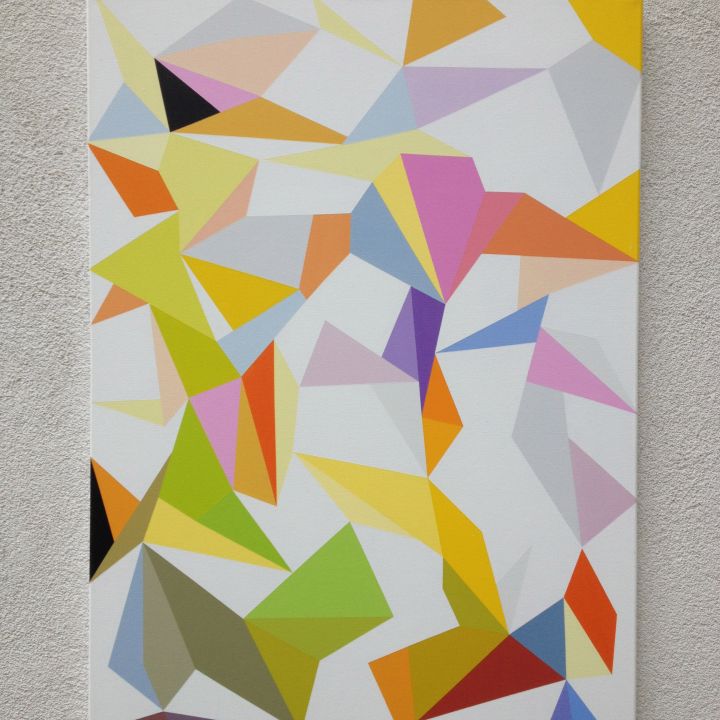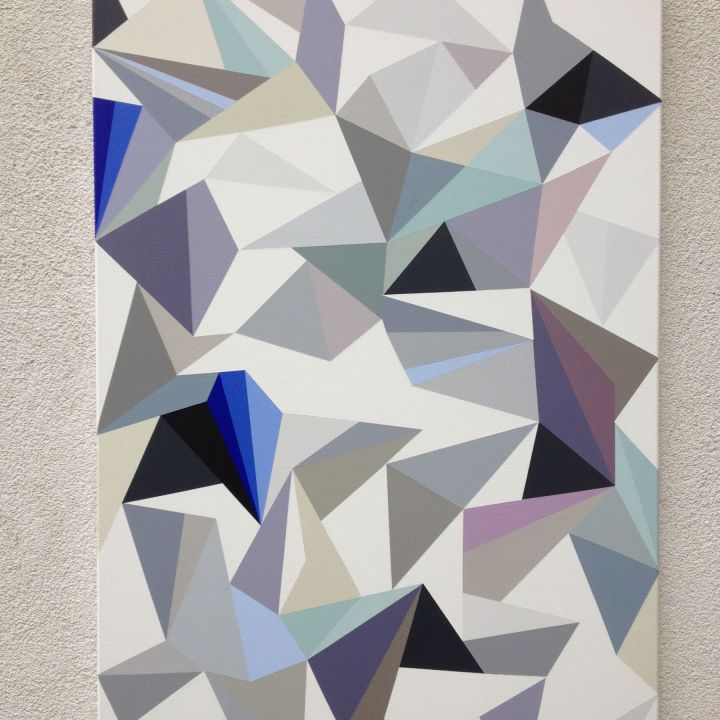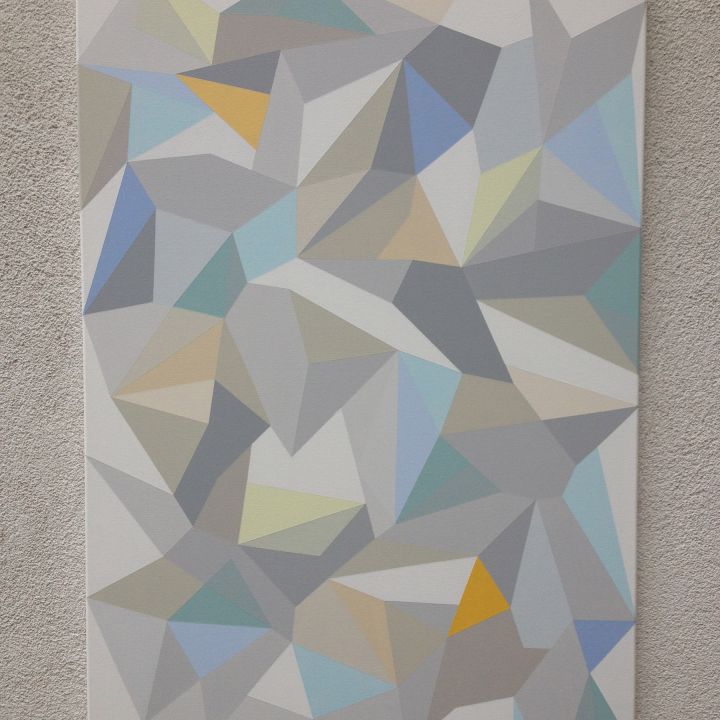"My new works, titled Mosaic, are related to a series of paintings I did earlier, titled Folded. I used tracing paper models to paint the series. It was important for me to paint transparent phenomena." István Halmi-Horváth
"The specificity of the folding process gave rise to concrete structural imagery, while at the same time the quality of "transparency" resulted in spectacular associations. These qualities are still important to me, but I wanted to create a series of images in which the formal elements are self-defined and not representations of 'something'.
For me, the cinema series is a playful experiment in which I experience the immediacy of creation. I don't use pre-designs, my geometric shapes develop directly on the canvas in relation to each other in an organic arrangement. My motifs meet each other in different shapes, colours and tones, creating a rich variety of possibilities for me to create different structures within a single painting, whose predecessors can be found in our immediate environment. I am thinking of the growth of sprouting crystals, plants, patterns created by natural forces or the structures of life in space, etc. For me they are not images of decay and disintegration, but of constructive processes. And as a painter, they create rich opportunities for expressing my experience of colour, in which I attach great importance to the colour white, which has a balancing power."
István Halmi-Horváth
"Organic painting that looks abstract-constructive
István Halmi-Horváth's relationship with the city of Veszprém is quite old. Thanks to his fine arts master, Árpád Szabados he also appeared as an artist's apprentice in our town until 2000, when he published a book of poems entitled Populus as a member of the 17 Castle Street/ Vár Ucca 17 books, which was created in the context of the contemporary European neo-avant-garde and can be considered a book on the border art. This publication like the others in the series was the subject of a review last year, which can be read in Tiszatáj. While that volume describes the world in linguistic and pictorial signs at the same time, Halmi-Horváth has abandoned the linguistic devices and concentrates exclusively on the visual and the thought that produces the visual. A relief by Halmi-Horváth can be seen in the Veszprém underpass and other works of his are occasionally on display in the Modern Art Gallery - László Vass Collection. Currently he is present here with a collection of 17 pieces entitled White Balance.
If you are observing one or more of István Halmi-Horváth's paintings, but especially those made in the last half decade, look at them as if they were landscapes, portraits or still lifes. One can notice the shapes, colours and their varied relationships in these seemingly abstract works. One day when our meticulous catalogue is complete we will be close to recognizing the pattern order. But let us watch and refine our experience. For example by naming colours. Umber, gold ochre, ochre, the various mixed colour greys, magenta, violet, cadmium yellow, chrome yellow, olive green, titanium white, Naples yellow, Naples rose, ultramarine blue, cobalt blue, indigo blue, ivory black, cadmium orange, cadmium red. If we persevere and succee, we will eventually acquire a wealth of knowledge about colouring, the colouring of paint, brush movement, picture editing and so on, sufficient to create a perfectly functioning universe.
The world of István Halmi-Horváth is a cryptically organic, but in its appearance constructive-abstract world. It is the result of an algorithm that can be traced in the details of the cosmos and bears the imprint of the particularities of thought and thus acquires anthropological meaning. We need not be alarmed by the sometimes extreme knowledge that we have of the works' creation. After all, what we see in the work is not only the end result, but also the imprint of the considerations, choices, techniques, materials, organisational characteristics and external and internal inspirations that have influenced it. Behind these, too, are contemporary characteristics that could not have characterized the art of other periods, other than our own. There are those who discover minerals and crystals in the view and derive the meaning of the image from them. The name of the earth paintings even confirms their view. They are examples of thinking by analogy. But there are those who identify the results of images or their starting point by spatial operations, mathematical procedures. It is understandable and typical of man that this need for interpretation and this kind of investigation can be used to identify not only paintings but also the human condition.
At this moment, Halmi-Horváth felt it necessary to say that the predecessors of the works now on show were made after models. Previously, he had folded sheets of paper to create his pictorial structures. Now, however, this sheet-folding and image-making takes place exclusively on the canvas, i.e. the preparatory process takes much less time and is the result of purely thought-emotional processes. In these paintings, the pictorial order is formed organically. As for the title of the exhibition: white balance is the process of correcting the image to be taken with the camera, to make it colour accurate in order to reproduce the colours most accurately. The white part, if we see it as white, means that the other colours are free from colour shift. According to the title of the exhibition, White Balance, i.e. counterpoint, the real colours are the focus of painterly interest and the works in their absolute minimalist way do not put anything else in the focal point. Of course, the question is how definable the limits of this are. Can the work flow over the folded back edge of the canvas or the stretching frame and how? How big and how much can the spot of colour be and in what shapes does it remain itself and when does it not become a simile, a quotation or even an allusion? What is more, how large can the panel itself be. Or can the tableau be eliminated by emphasising certain spatial features?"
Opening text by János Géczi poet
"Everything we see can be different, everything we hear can be different, there is no a priori order to things." (Ludwig Witgenstein)
"One of the most important experiences of my childhood is playing: looking at the delicately stained tiles on the floor, on the wall, squinting or moving my head a little and always seeing something different, always new faces or stories unfolding before me. The number of stories and worlds I imagine depends only on how much time I have to contemplate. One part of István Halmi-Horváth's exhibition - the cinema series - evokes the same experience, childlike and playful in the most noble sense of the word. We cannot put this painting into the boxes so much favoured by adults: it is at once concrete, abstract and organic. It is concrete painting because the formal elements are not representations of something, but are self-defining; it is abstract painting because it lacks any intended narrative. Because where do we stand with abstract art? With a very concrete, contemporary example, both economic and aesthetic: something like when you win a shampoo carpet cleaning by vacuuming - without the need to buy - and you realise how much can accumulate on a carpet, a fabric, a mattress over many years, decades, centuries. But the stains and traces we leave behind us are not a reminder of events that have happened, but an abstract condensation of them, as Kazimir Malevich would say: it is the feeling as such that is essential. These works are also organic, however, because the geometric forms appear in an organic arrangement giving us a sense of movement, of blossoming or flight, and thus of birth and passing away at the same time, perhaps the most beautiful image, in which the yellow forms slowly fade and then disappear. These yellow motifs, like Malevich's yellow paralelogram are ethereal, insubstantial, there is something timeless in their existence. Most of the mosaic images, on the other hand, are full of life, vivid, sensual, passionate, everything is alive and moving, crystals and plants are growing.
One of the most important features of István Halmi-Horváth's art is repetition, not only in the creation of similar works that allow permutation, but also in the repetition within a single work, with forms arranged in series, sequences. Repetition is the most important means of knowing oneself and the world, art itself is a repetition, as Gilles Deleuze says in contrast to Plato: the work of art is not a lower order imitation, but a repetition of the highest order, in art the fundamental mode of being of all things, repetition. Repetition is the lovechild of metaphysics mother and dialectics father and, as we know, the mother of knowledge. As Paul Valery said in one of his notebooks, "The first reaction of the intellect is to repeat as quickly as possible what the sensibility has painted before it, has tweaked, has lost, has improvised out of nothing - and then goes on - while it tries to understand, repeats and slowly, slowly understands because it has repeated and repeated."
An important question about these works is the question of organisation and disorganisation. In contrast to Simon Hantai, who created his seemingly similar paintings with a special technique of image-making, the so-called pliage, i.e. by folding, crumpling and painting the canvas on large surfaces, he created abstract patterns using the free image-making method of abstract expressionism, gesture painting, István Halmi-Horváth does not create his forms, colours and tones in a random but precise way. The loose organisation of form, in turn creates the possibility of contingency, the phenomenon already mentioned: our imagination is given wide scope to see elements of the visible world in them. If the cinema images are structured disorder, the series of colour structures is structured orderliness. For István Halmi-Horváth the image is an entity in its own right, which is why he paints the sides of the paintings in the colour structures series, emphasising that we are dealing with a three-dimensional thing, as opposed to the two dimensions that are common in painting. These paintings consist of two parts: a monochrome surface and a colour-striped surface. The different colours, the power, the lack of focus make these paintings vibrate and move, like the images in the cinema series. Painters usually turn to geometric forms because they can create the most perfect image of the structure of the world. These images postulate the absolute behind phenomena, the eternity of the idea, that there are eternal values that exist in themselves because concepts remain identical to themselves and that our imperfect material world is but a reflection of the world of eternal and unchanging ideas.
István Halmi-Horváth's painting is an organic continuation - I am only mentioning Hungarian art - of the geometric art of Lajos Kassák and László Moholy-Nagy from the early to mid 20th century, on the one hand, and of the painting of the still living "great old men" Imre Bak and Tamás Hencze, on the other. His perfectly, precisely painted canvases, which nevertheless offer the possibility of unbridled interpretation and whose repetition is one of their most important qualities, are more akin to those of his contemporary painters, such as András Bernát or the recently deceased András Braun. Many people do not know that the only original Hungarian "ism" that is recognised internationally is the art of Kassák - and the emphasis was on the original, not the ism. And why do I mention this? Because I see or think of contemporary Hungarian geometric/concrete/abstract/organic/nonfigurative/non-representational painting as more original than at any time since Kassák. That's why we can't put it in our favourite drawers, we would probably have to create new words, concepts and terms for it."
Viola Farkas art historian




